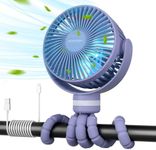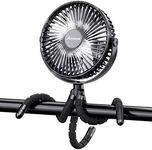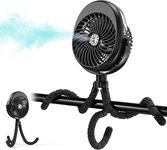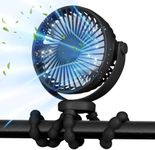Buying Guide for the Best Stroller Fans
Choosing the right stroller fan can make outings with your baby much more comfortable, especially during warm weather. A good stroller fan keeps your child cool and happy, but with so many options available, it’s important to know what features matter most. By understanding the key specifications, you can select a fan that fits your stroller, meets your cooling needs, and is safe for your child.Mounting MechanismThe mounting mechanism refers to how the fan attaches to your stroller. This is important because a secure and flexible attachment ensures the fan stays in place and can be positioned for optimal airflow. Common types include clip-on, flexible tripod legs, or straps. Clip-on fans are quick to attach but may not fit all stroller frames, while flexible tripods can wrap around various shapes and offer more positioning options. Consider the design of your stroller and where you want to place the fan to choose a mounting style that will be stable and convenient for you.
Power SourceThe power source determines how the fan operates—most stroller fans use rechargeable batteries, replaceable batteries, or USB power. Rechargeable fans are convenient and eco-friendly, but you need to remember to charge them. Replaceable battery fans can be handy for longer outings if you carry spare batteries. USB-powered fans are great if you have a portable charger. Think about how long you’ll be out and whether you prefer the convenience of recharging or the flexibility of swapping batteries to decide which power source suits your lifestyle.
Fan Speed SettingsFan speed settings control how much air the fan moves. More speed options let you adjust the airflow to match the weather and your child’s comfort. Some fans have just one or two speeds, while others offer three or more. If you’ll be using the fan in different environments or want to fine-tune the breeze for your baby, look for a model with multiple speed settings. If you only need a gentle breeze, a simpler fan may be enough.
Blade SafetyBlade safety is about how well the fan protects little fingers from getting hurt. Fans with soft foam blades or tightly spaced grills are safer for babies and toddlers who might reach for the fan. This is especially important if your child is curious or likely to touch the fan. Always check that the fan’s design prevents access to the spinning blades to ensure your child’s safety.
Noise LevelNoise level refers to how loud the fan is when running. A quieter fan is less likely to disturb your baby’s nap or make outings less peaceful. Some fans are designed to be ultra-quiet, while others may produce a noticeable hum. If your child is sensitive to noise or you plan to use the fan during naps, look for a model that is specifically described as quiet or low-noise.
Size and PortabilitySize and portability affect how easy it is to carry and use the fan on the go. Smaller fans are lightweight and easy to pack, but may not provide as much airflow. Larger fans can be more powerful but might be bulkier to carry. Consider how much space you have on your stroller and how much cooling you need. If you travel a lot or have limited space, a compact fan is a better choice.
Battery LifeBattery life tells you how long the fan can run before needing a recharge or new batteries. Longer battery life is important for all-day outings or trips where charging isn’t possible. Battery life can range from a couple of hours to over ten hours, depending on the fan and speed setting. Think about how long you’ll typically use the fan and choose one that can last through your usual activities without running out of power.














![MILPROX USB Clip On Fan 7200 mAh [24 Hours Continues use] Battery Operated Rechargeable Portable MINI Handheld Desk Fan for Baby Stroller Car Gym Home Office Outdoor Traveling and Camping - White](https://images-proxy.bestreviews.guide/8KJBotvkM5OiJSTmro1w7h351pE=/0x150/https://m.media-amazon.com/images/I/41Mw0wiluJL._AC_CX679_.jpg)

